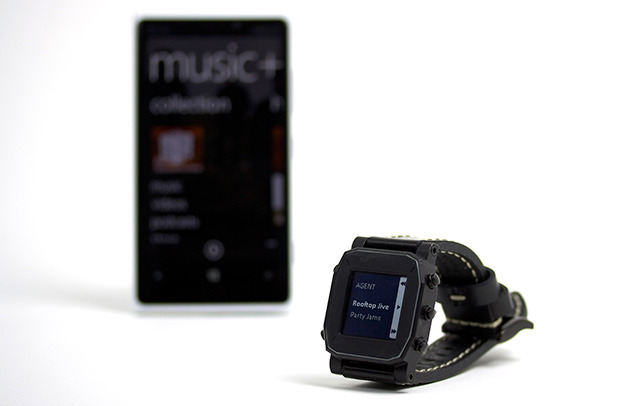Editor’s note: Ross Rubin is principal analyst at Reticle Research and blogs at Techspressive. Follow him on Twitter @rossrubin.
Stop me if you’ve heard this one. A guy walks into a watch store and a smartwatch business partnership is formed. OK, it’s not a funny joke; in fact, it’s not a joke at all. Secret Labs’ founder and CTO Chris Walker walked into the House of Horology store on Prince Street owned by neighbor Lawrence Layderman. A discussion about the future of watches led Walker to show Layderman a prototype of a state-of-the-art smartwatch he had already been working on for a year and a half.
Walker’s company had previously created the Netduino, an Arduino alternative that allows developers to use Microsoft’s developer tools. But as anyone who has ever seen most of those projects knows, they’re usually not known for their aesthetics. Walker knew he had to partner with a company that understood fashion, but he still wanted to maintain control over the project.
The partners launched a Kickstarter campaign for its Agent smartwatch, which blew through its funding goal in the first nine hours. Now, with less than a week before it closes, it has attracted nearly $900,000 from nearly 5,000 backers, many of whom will be picking up the American-made device for about $150 even though the watch is expected to retail for $100 more than that.
 The Agent is a bit thinner than House of Horology’s beefy color-accented Bedlam line, key to attracting more upscale shoppers who will encounter the device at its store and other retailers. Despite this, it brims with state-of-the-art components. These include a charging coil to support the Qi wireless charging standard. One of its two processors is a new chip from ARM — the Cortex M4 — that won’t be shipping until the summer.
The Agent is a bit thinner than House of Horology’s beefy color-accented Bedlam line, key to attracting more upscale shoppers who will encounter the device at its store and other retailers. Despite this, it brims with state-of-the-art components. These include a charging coil to support the Qi wireless charging standard. One of its two processors is a new chip from ARM — the Cortex M4 — that won’t be shipping until the summer.
“We’ve effectively done for watches what Haswell has done for processors,” Walker says. The processors team with a next-generation Sharp Memory LCD for some of the best battery life in the category. Agent even supports a licensed version of the Monotype font library to display foreign language characters.
The team has also thought about how to protect against things not going so well. It can be restored via a button-press combination in the event a firmware update goes awry. In addition, it searched globally for a rechargeable lithium ion watch battery that wouldn’t explode if punctured, a concern for something kept so close to the body.
But some things will remain out of reach. For example, the team couldn’t yet find a color display that presented anything richer than pastel colors. And as for using the phone as a headset, Walker says the project looked into integrating a speaker or microphone to activate features, such as Siri, as the Martian watch does. But the team decided against it, with Walker characterizing taking a call through a watch as “the worst speakerphone experience you’ve ever had.”
The Agent may be loaded with the latest components. Technology, though, becomes available to many in successive generations and it’s easy to imagine a second-generation watch from one of the Smartwatch Class of 2012 upgrading beyond what the Agent has locked down. That said, not all watches are open platforms and, as many Kickstarter projects go, some only create development kits optionally after reaching a stretch goal or shipping.
Not so for the Agent, which was created with third-party developers in mind. Here, too, it is not the first. WIMM Labs worked on whittling down Android before being entering into an exclusive, confidential relationship with an unnamed company. MetaWatch, another Kickstarter alum, served as “a lot of the inspiration for what we did,” according to Walker. The Agent, though, relies on Microsoft .NET, which allows developers to use a wide array of tools to create apps for it, as well as take care of lots of things under the hood. That might not matter much for a watch face, but it could become more of an advantage as capabilities grow.
Despite this, don’t expect too much to differentiate Agent apps at launch. The Agent will be hosting the kinds of apps, including weather, golf swing analyzers and sleep and exercise trackers. Walker expresses faith that developers will create the kind of unforeseen titles that came to flood the Apple app store.
While the House of Horology support has helped with the design up front, it will be at least as helpful when it comes to distribution, a challenge that confronts many tech products after a successful Kickstarter campaign. As the steward of a young luxury brand, Layderman says that his consumers are now looking for a more well-rounded timepiece. While the first Agent is being designed as a unisex watch, interest from women is driving exploration into even smaller casings. The partners think that they can expand far beyond the current watch market to target retailers in the fashion space, phone accessory and electronic enthusiast markets.
Still, despite attracting dalliances from the likes of Sony and Motorola, as well as less ambitious efforts from Casio and Citizen, many of the smartphone-tethered smartwatch market entrants have attracted mostly crowdfunded startups, and the big ecosystem providers have all been rumored to be developing wristwear; Walker provides the classically optimistic take that their entrance will validate the category.
But the particular areas on where the Agent watch partnership has focused — Secret Labs’ development and House of Horology’s distribution — seem particularly vulnerable to the entrance of an Apple smartwatch. “Hopefully, we can all move this forward together. They’re welcome to call us,” says Walker. Still, for any new smartwatch, the clock may be ticking.
